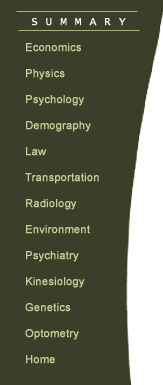|
Economics
Pregnant women are involved in more highway accidents
It may be dangerous
to drive a car during pregnancy, especially in the first months.
This is what different studies carried out in the past 15 years
in Quebec and Norway seem to conclude.
"The correlation is statistically strong-in other words far
from zero-but the effect of pregnancy on the number of accidents
remains small," notes Professor Marc Gaudry, director of Agora
Jules Dupuit (AJD), a transportation economics research group at
Université de Montréal, who was the first to identify
this factor in 1984. Using algorithms that correlate several dozen
factors, the researcher observed a statistically significant correlation
between the number of pregnancies and the frequency and seriousness
of highway accidents. The model developed at that time, called DRAG-1
(standing for highway demand, accident and their severity)-was applied
in a second study of this problem in 1991, which led to the same
conclusions. Then, in 1997, a team in Norway led by Dr. Lasse Fridstroem
also established a significant correlation with even more accurate
data. "Based on these results, the Norwegian government launched
in 2000 a review of all highway accidents involving women that had
taken place in the past 25 years in order to check whether they
were pregnant," added Mr. Gaudry. These new Norwegian results
are expected to be made available by the Transport Economics Institute
(TOI) of Oslo this autumn.
The DRAG-1
model revealed another surprising correlation that had never been
suspected before: low alcohol consumption is associated with a lower
risk of accident than abstinence. Once again, care has to be taken
when making this analysis, since it is the same kind of indirect
relationship: when alcohol consumption per person increases in a
given population, the number of fatal accidents and the number of
deaths per accident both decrease, while the number of less serious
accidents increases. "Our model gives us a new way of understanding
the problem of highway accidents, by considering the frequency and
seriousness of accidents separately, as these two elements are not
influenced by the same factors. If it snows, for example, the number
of accidents increases, but the accidents are less serious than
accidents that occur in good weather. On the other hand, the frequency
decreases at higher speeds, because drivers are often more alert,
although their accidents are more serious." The algorithms
developed by Marc Gaudry show a similar correlation with alcohol
consumption, in particular consumption of wine. "Initially,
we thought that our model was wrong," he admits. But similar
results were obtained with a second version of DRAG, and then by
teams in New Zealand, Norway and Germany, as well as by an empirical
study in the United States. According to Gaudry, the explanation
is as follows: small doses of alcohol may produce a calming effect
that reduces aggressiveness and tends to make for slower driving.
The problem is to determine what is meant by "small dose."
These results are described in a book, published in November 2000
by Elsevier Science, Oxford, entitled "Structural Road Accident
Models: the International DRAG Family".
Researcher
: Marc Gaudry
Phone:514 343-7284
Funding : Société de l'assurance automobile du Québec
(SAAQ), Transport Canada, the Alexander von Humboldt Foundation
(AvH) of Germany and the Conseil National de la Recherche Scientifique
(CNRS) of France
|
